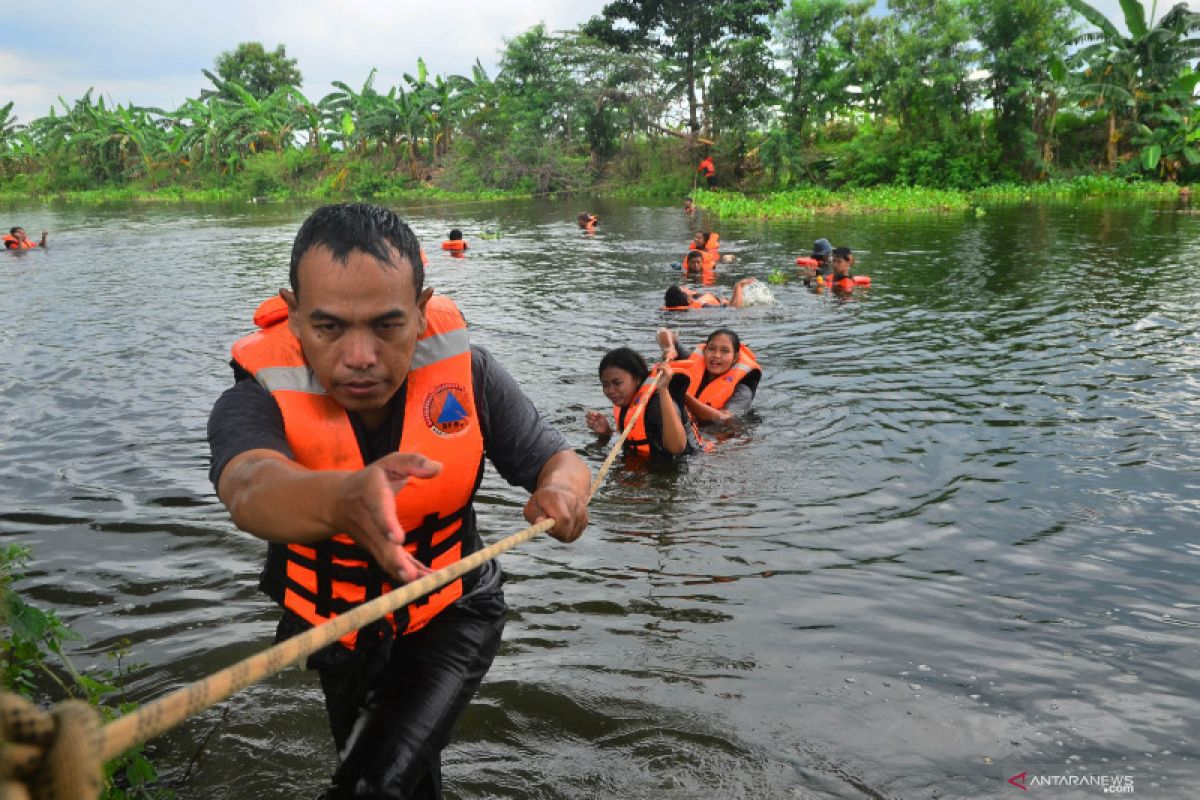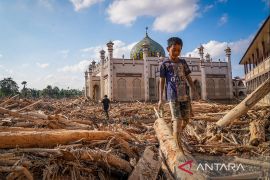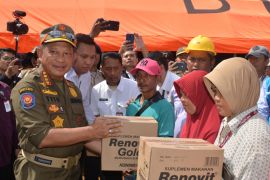We must consider every possible incident to avoid the worst impact of natural disaster with minimal casualtiesJakarta (ANTARA) - Indonesia is known as a disaster-prone country since it is located at the confluence of four tectonic plates: the Asian Continent plate, the Australian Continent plate, the Indian Ocean plate, and the Pacific Ocean.
The interactions between the plates produce an energy build-up that can trigger earthquakes, which can also cause a tsunami afterward.
In addition, there is a volcanic belt in the southern and eastern parts of Indonesia, which extends from the islands of Sumatra, Java, Nusa Tenggara to Sulawesi, with old volcanic mountains on the sideline and lowlands, which are partly dominated by swamps. This condition has the potential to trigger volcanic eruptions, earthquakes, floods, and landslides.
Indonesia is also located in a tropical climate area with two seasons -- hot and rainy -- with characteristics of extreme changes in weather, temperature, and wind direction, thereby making it vulnerable to hydrometeorological disasters, such as floods, landslides, forest fires, and droughts.
Not to mention, irresponsible human activities in nature may also increase the number of disaster risks. Moreover, it is necessary to build and strengthen disaster preparation in order to create disaster-resilient communities, especially in disaster-prone areas in Indonesia.
Related news: Collaboration, preparedness crucial to reduce disaster impacts: BNPB
One of the important efforts deemed necessary is to develop, stipulate, and socialize the Indonesian National Standard (SNI) for Disaster. The Disaster SNI needs guidance, information dissemination, and its application to the grassroots level.
The role of a disaster-responsive local government and the supporting infrastructure in accordance with the Disaster SNI is important to create a disaster-resilient community. The question is, has the Disaster SNI been used and applied to protect the community in disaster-prone locations?
Disaster SNI
From 2011 to 2022, Indonesia, through the National Standardization Agency (BSN), had issued and stipulated 23 SNIs related to disasters to support disaster mitigation and preparation efforts at the national and regional scale.
BSN has formed a Technical Commission (Komtek) 13-08 whose task is to formulate and fulfill the needs of Disaster SNI. The committee comprises 15 people as representatives of the stakeholders.
According to Chairman of Komtek 13-08 Dr Udrekh, who is concurrently the Acting Director of the Disaster Mitigation System for the National Disaster Mitigation Agency (BNPB), Indonesia is the first developing country in the world to initiate and oversee the preparation of a series of the International Organization for Standardization (ISO) documents related to a community-based early warning system.
Related news: National disaster mitigation standards can serve as common reference
Komtek 13-08 actively formulates and develops SNI for disaster and adapts it to the Sendai Framework for Disaster Risk Reduction 2015-2030.
The 23 SNIs related to disasters include SNI 7743:2011 Tsunami evacuation signs, SNI 7766:2012 Tsunami evacuation routes, and SNI ISO/PAS 22399:2012 Community protection- Guideline for incident preparedness and operational continuity management (ISO/PAS 22399:2007, IDT).
The others include SNI ISO 22300:2012 Public safety Terminology, SNI ISO 22320:2012 Community security - Emergency management - Requirements for handling Societal security incidents - (ISO 22320:2011, IDT), and SNI 7937:2013 Humanitarian services in disasters.
SNI ISO 22301:2014 Community security - Business continuity management system - Societal security requirements - Business continuity management systems - Requirements (ISO 22301: 2012, IDT), and SNI ISO 22315:2015 Societal Security – Mass evacuation – Guidelines for Planning (ISO 22315:2014, IDT) are among the others.
The others comprise SNI 8289:2016 Volcanic eruption evacuation routes and signs, SNI 8291:2016 Preparation and determination of ground movement vulnerability zones, SNI 8040:2017 Tsunami early warning sirens, SNI 8182:2017 Disaster risk assessment at national and provincial levels, and SNI 8235: 2017 Earth movement early warning system.
There is also SNI 8288:2017 Management of disaster mitigation training, SNI 8357:2017 Disaster-resilient villages and sub-districts, SNI 8358:2017 Management of preparedness training for tsunami disasters, SNI 8039:2018 Management of preparedness training against volcanic eruptions, and SNI 8751:2019 contingency planning.
In addition, there is SNI 8840-1:2019 Disaster early warning system – Part 1: General, SNI 8840-2:2020 Disaster early warning system – Part 2: Tsunami, and SNI ISO 22301:2019 Security and resilience – Business continuity management system – Security and resilience requirements (ISO 22301:2019, IDT).
The others include SNI 9021:2021 Early warning equipment for ground movement and SNI 9050:2022 Epidemic disaster management system.
Related news: BRGM highlights mangrove rehabilitation's role in disaster mitigation
Several institutions, including the Indonesian Red Cross (PMI), whose activities include building community resilience, use SNI 8357:2017 for disaster-resilient villages and sub-districts as a reference for program implementation, monitoring, and evaluation.
A resilience test kit has also been supplied in the form of a "Village Resilience Assessment Toolkit". Tests have been conducted for villages along the South Coast of Java and the West Coast of Sumatra from West Sumatra to Aceh.
The Special Region of Yogyakarta, the Bengawan Solo Watershed (DAS), and villages around Mount Merapi and Mount Kelud have also implemented SNI 8357:2017 to implement the program in most of its disaster-prone villages.
Full commitment
Deputy for Standard Development of BSN Hendro Kusumo affirmed that all parties must commit to applying the disaster guidelines that are mutually agreed upon by all stakeholders in the form of SNI.
The implementation of disaster risk mitigation guidelines, especially in disaster-prone areas, is a necessity to ensure the effectiveness of policies as well as a guidance in the field.
Disaster SNI can be directly referenced in regional regulations to speed up the regulation drafting process to generalize disaster regulation within all areas in Indonesia.
As the supervisor of Standardization and National Conformity Assessment, BSN always synergizes and collaborates with all elements of stakeholders -- BNPB and the Regional Disaster Mitigation Agency (BPBD) -- as the spearhead of disaster mitigation, as well as with local governments.
"The role of BSN is more of a supporter, but in some cases, it also disseminates information, education, or conducts other activities, especially in the context of implementing the existing MoU (mutual agreement) with the local government," Kusumo stated.
His side later plans to raise awareness of Disaster SNI in five provinces with Disaster Resilient Villages (Destana): Serang District/City in Banten, Gunung Kidul District in Yogyakarta, Tulung Agung in East Java, Pangandaran and Sukabumi in West Java, and Kebumen in Central Java.
The key to ensure the successful implementation of SNI is the consistency of guidance or assistance where for the initial stage it should be supported by the availability of regulations or policies as an umbrella for an integrated program that will become a monitoring and evaluation tool and for continuous improvement.
“We must consider every possible incident to avoid the worst impact of natural disaster with minimal casualties,” he noted.
Related news: 23 national standards developed to manage disasters in 11 years: BSN
The Disaster SNI will help local authorities, alert teams, and the community to have similar understanding and standard guidelines in capturing early warning and disaster response to anticipate the impact of disasters.
The availability of Disaster SNI as a guide is expected to facilitate stakeholders in managing disaster aspects, especially for disaster risk mitigation. By disseminating information and implementing SNI at the regional level, synergy and cooperation is expected to be built to create disaster-resilient regions and communities.
Related news: Long-waited Eid al-Fitr mudik relatively safe, smooth this year
Related news: Demanding probe into Shireen Abu Akleh's murder by Israeli forces
Editor: Fardah Assegaf
Copyright © ANTARA 2022












